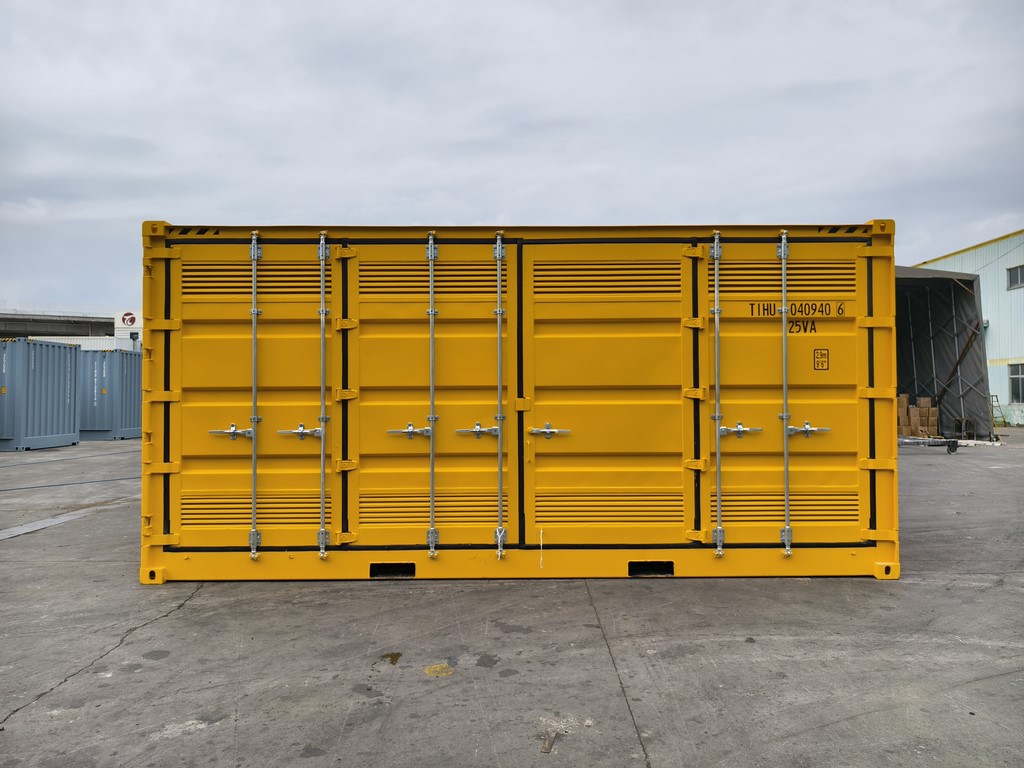While standard shipping containers can carry most cargo, hazmat storage containers are often needed in certain situations.
Although they look visually similar to standard containers in many aspects, hazmat containers are so different in terms of features.
So, how are hazmat storage containers different from their standard counterparts? Read more below!
Also Read: Shipping Container Deck: Perfect Addition for Container Homes
What is a Standard Shipping Container?
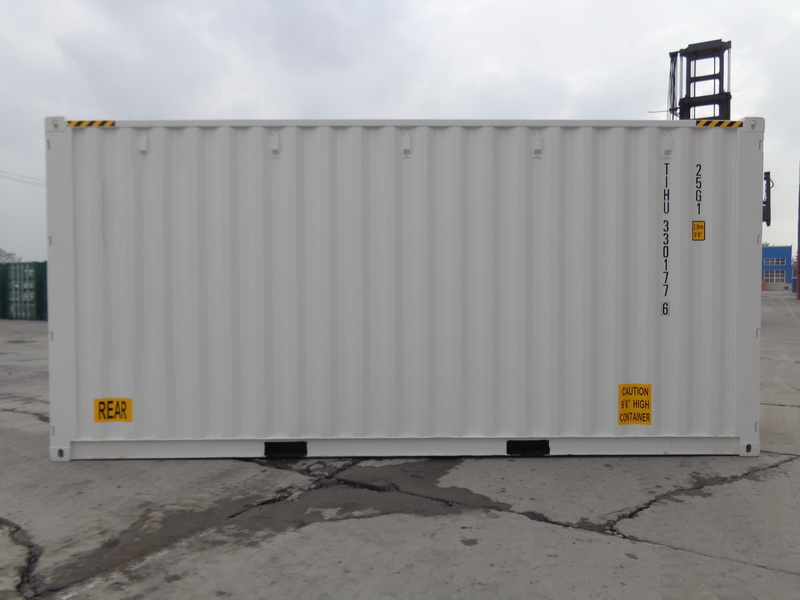
Before starting on hazmat containers, let’s have some refreshers on what standard containers are!
As we know, standard shipping containers are designed for general cargo transport. They are typically made from durable steel and come in various sizes, such as 20-foot and 40-foot containers.
These containers provide a secure and weatherproof environment for goods during transit, making them suitable for many products, including electronics, clothing, machinery, and more.
Standard containers can handle the rigors of transportation by sea, rail, or road. They are stackable and have reinforced corners, allowing for efficient space utilization during shipping.
Common Uses for Standard Shipping Containers
Apart from using them as traditional cargo platforms, we can use standard shipping containers for these purposes:
- Storage Solutions: Many businesses use standard containers as on-site storage units due to their durability and security features.
- Pop-Up Shops: Entrepreneurs often convert standard containers into mobile retail spaces or cafes.
- Workshops: Artists and craftsmen utilize containers as workshops or studios.
- Residential Spaces: You can convert standard containers into stylish homes or guest houses with proper modifications and workaround.
What is a Hazmat Shipping Container?
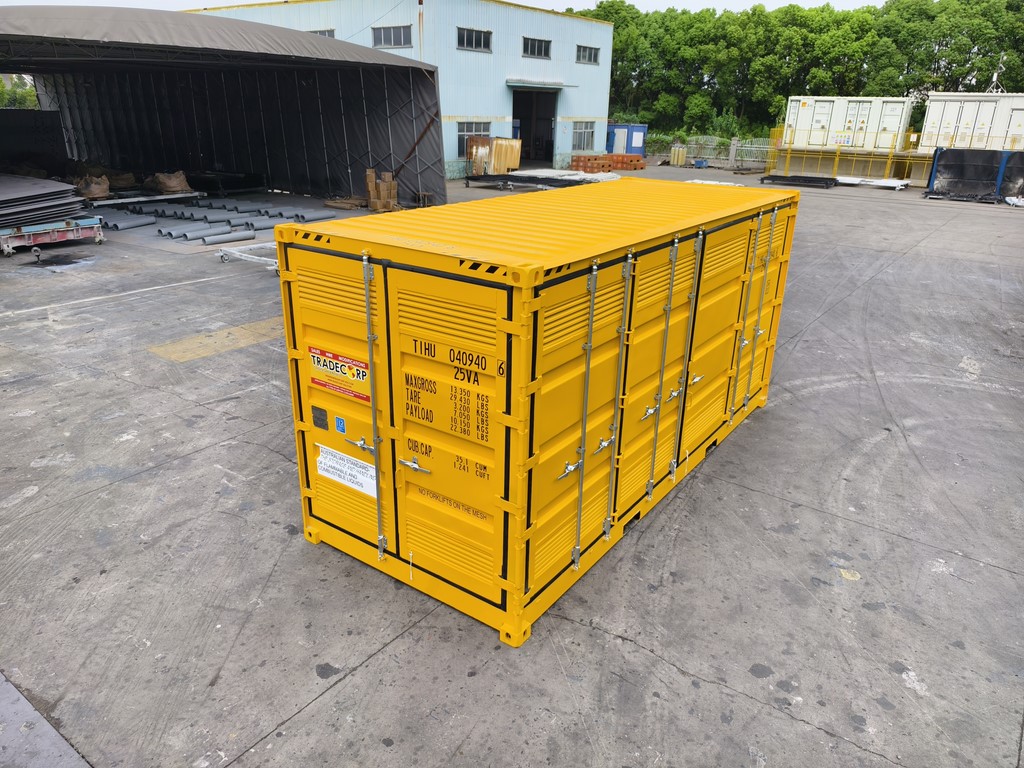
By now, we understand what standard shipping containers function and look like. How about hazmat storage containers?
Unlike standard containers, builders design hazmat containers to transport hazardous materials safely. These materials can include flammable liquids, corrosive substances, toxic chemicals, and other dangerous goods that pose risks to health and safety during transport.
Hazmat containers must meet strict regulations set by organizations such as the U.S. Department of Transportation (DOT) and the International Maritime Organization (IMO).
Because of that, hazmat containers have features that ensure safe handling and transport of dangerous goods, including:
- Ventilation Systems: To prevent the buildup of harmful gases.
- Fire-Retardant Materials: To reduce the fire risks in case of an incident.
- Secondary Containment: To contain spills or leaks.
- Labeling and Marking: Clear markings indicating the type of hazardous material being transported.
Common Uses for Hazmat Shipping Containers
Industries commonly use hazmat storage containers for the following purposes:
- Chemical Transport: Industries that handle chemicals often use hazmat containers to move substances like acids or solvents.
- Medical Waste Disposal: Hospitals and clinics utilize hazmat containers to transport medical waste securely.
- Oil and Gas Products: Companies in the energy sector use hazmat containers to transport flammable products like crude oil or natural gas.
- Battery Transport: Lithium-ion batteries require special handling due to their potential hazards during transit.
Key Differences Between Standard and Hazmat Shipping Containers
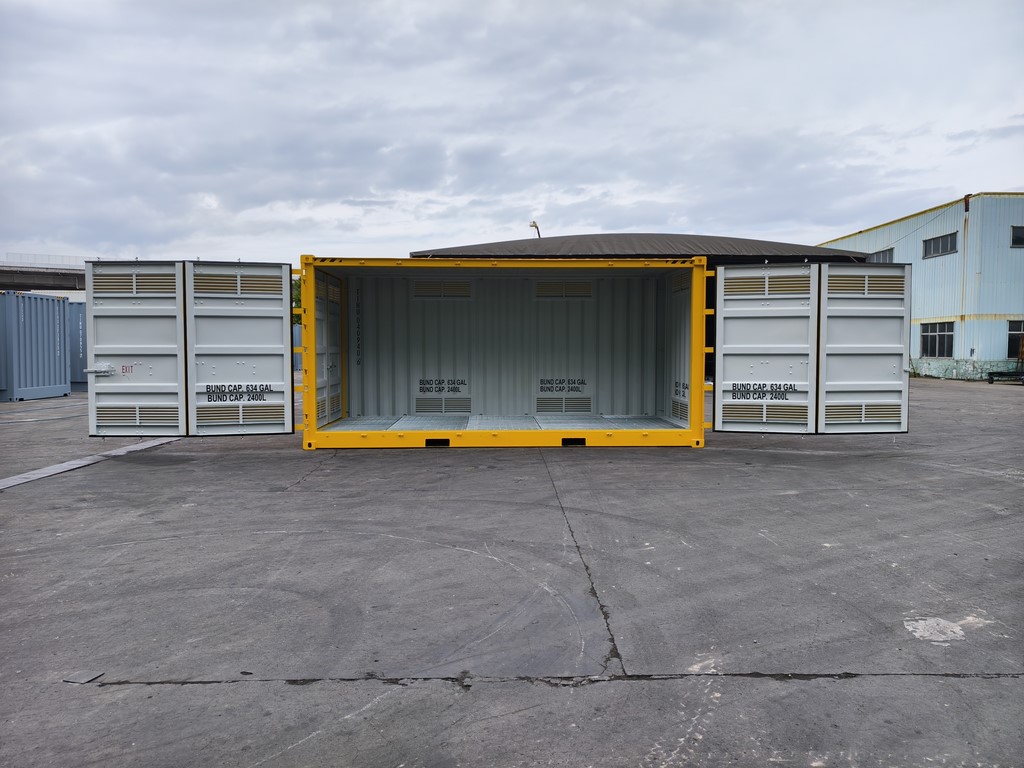
Because hazmat containers have different uses and purposes than standard containers, in what ways do they differ from standard steel boxes?
Design Specifications
While standard shipping containers focus on general cargo transport, hazmat containers incorporate specific design elements to handle hazardous materials safely.
This includes reinforced walls, specialized ventilation systems, and secure locking mechanisms to prevent leaks or spills.
Regulatory Compliance
Hazmat shipping containers must comply with stringent regulations governing the transport of dangerous goods.
These regulations include standards outlined by the DOT’s Hazardous Materials Regulations (HMR) and international guidelines from organizations like the United Nations (UN).
On the other hand, standard containers do not require such rigorous compliance unless you use them to transport hazardous materials.
Labeling Requirements
Hazmat containers must have proper labeling according to regulations that specify how dangerous goods should be marked.
Specific symbols and UN numbers that indicate the type of hazard associated with the contents are commonplace in hazmat containers.
Inspection Protocols
Containers transporting hazardous materials undergo more frequent inspections compared to standard containers.
This ensures that they remain compliant with safety regulations throughout their lifecycle. Inspections focus on structural integrity, proper labeling, and functionality of safety features like ventilation systems.
Cost Implications
Because of their design and regulatory requirements, hazmat shipping containers often have higher costs than standard containers.
As a result, businesses must consider these costs against the potential risks associated with transporting hazardous materials.
Insurance Considerations
Transporting hazardous materials typically requires specialized insurance coverage due to the increased risks.
This means businesses must consider higher premiums when using hazmat shipping containers compared to standard options.
Training Requirements
Employees handling hazmat shipments often need specialized training by OSHA regulations and DOT guidelines.
Such training covers safe handling practices, emergency response protocols, and proper labeling techniques.
When Should You Use Hazmat Shipping Containers?
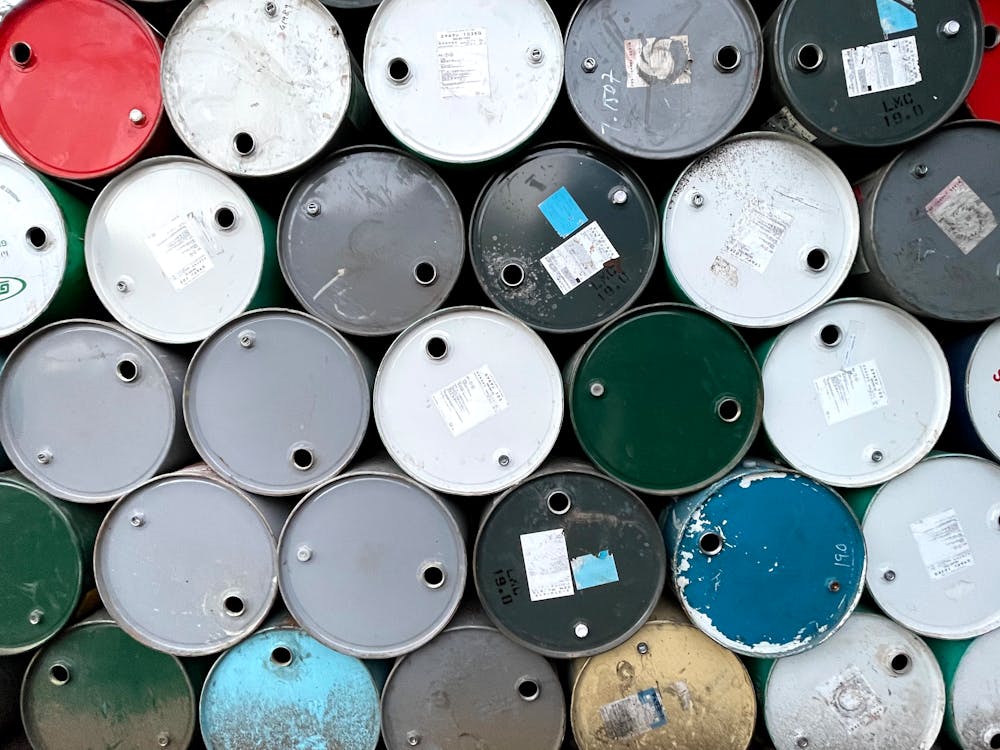
The following situations often demand everyone to use hazmat storage containers because they pose more risk than your standard cargo materials.
Transporting Chemicals
If your business deals with flammable, corrosive, or toxic chemicals (industrial solvents or cleaning agents), you must use hazmat shipping containers that can handle them.
Shipping Batteries
Lithium-ion batteries pose significant hazards during transport due to their potential for overheating or exploding.
Using hazmat containers ensures compliance with safety regulations while protecting against accidents.
Handling Medical Waste
Medical facilities often generate hazardous waste due to its potential risks to human health or the environment.
Properly labeled hazmat shipping containers ensure this waste is transported safely and in compliance with regulations.
Transporting Oil or Gas Products
Oil products can be highly flammable and pose environmental risks if spilled during transport.
Utilizing hazmat shipping containers helps mitigate these risks while ensuring compliance with industry standards.
Moving Paints or Coatings
Many paints contain volatile organic compounds (VOCs) that can be harmful if you inhale or improperly handle them.
Hazmat shipping containers provide a safe way to transport these substances while adhering to safety regulations.
Features of Hazmat Shipping Containers
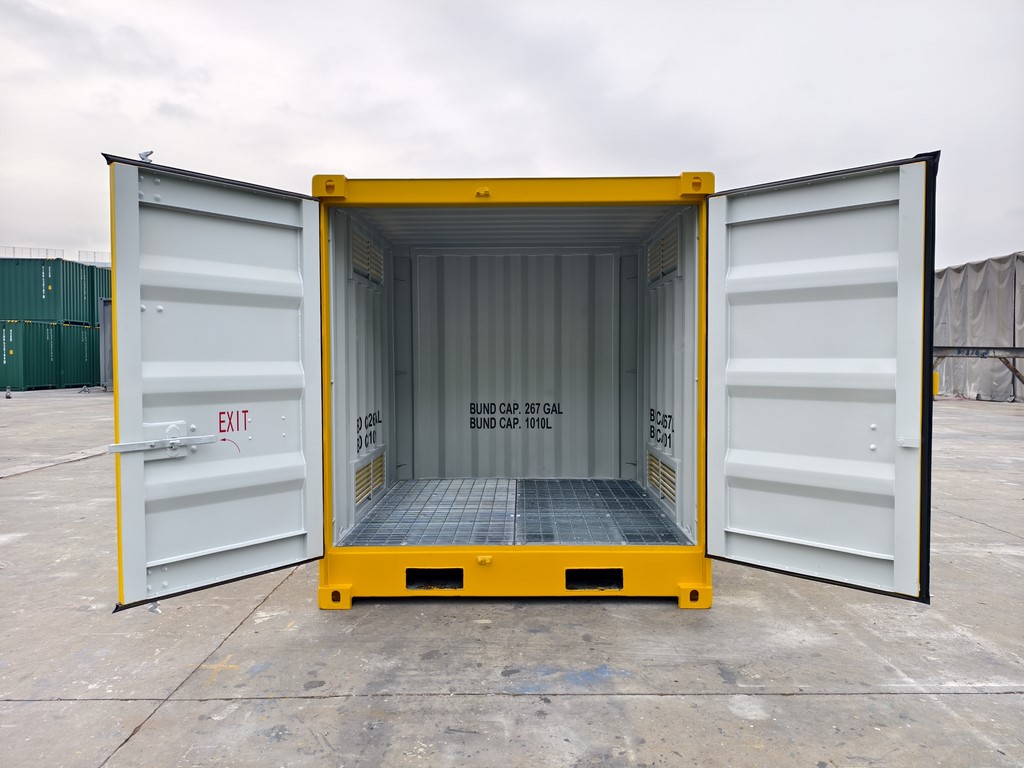
Because of the nature of the cargo they carry, these features are mainstay characteristics of hazmat containers:
Enhanced Structural Integrity
Hazmat containers often have reinforced walls that can withstand impacts that could occur during transit while protecting against leaks or spills.
Ventilation Systems
Proper ventilation is crucial when transporting volatile substances, so hazmat containers often include ventilation systems that allow for safe gas release.
Secondary Containment Systems
To manage any potential spills effectively, many hazmat shipping containers feature secondary containment systems that capture leaks before they spill out.
Fire Safety Features
Hazardous materials may cause fire – therefore, many hazmat shipping containers incorporate fire-retardant materials in their construction to minimize this risk during transit.
Maintenance Considerations
While standard and hazmat shipping containers require regular maintenance, you need some extra measures when it comes to the latter.
- Regular Inspections: Conduct routine inspections on both internal structures (for signs of corrosion) and external components (like seals).
- Cleaning Protocols: Ensure thorough cleaning after each use (especially if transporting hazardous materials) to prevent contamination.
- Documentation: Maintain accurate records regarding inspections performed on each unit along with any incidents reported during transportation processes involving hazardous goods.
Also Read: How to Insulate a Shipping Container from the Elements
Conclusion
By using hazmat storage containers, you do not have to worry about spilled dangerous materials anymore when you transport them. To source the best hazmat containers, contact Tradecorp today! With over 35 years of experience in the industry and a wealth of choice of offerings, you can find any shipping container type you need to meet business demands.

